Traveling With Angels: A Visit to Northern Evia, Part 2
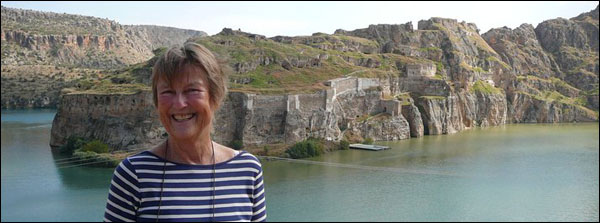
“Candili, named after the mountain above it, is one of the oldest foreign-owned properties in Greece. Formerly named Achmetaga, it was bought by Annabella Byron’s cousin Edward Noel from Hadji Ishmail Bey, an Ottoman pasha, in the 1830s. Lady Byron had dispatched her relative to investigate the circumstances of her mad bad husband’s death in Missolonghi.” Diana Farr Louis
Eating Well Is The Best Revenge
By Diana Farr Louis
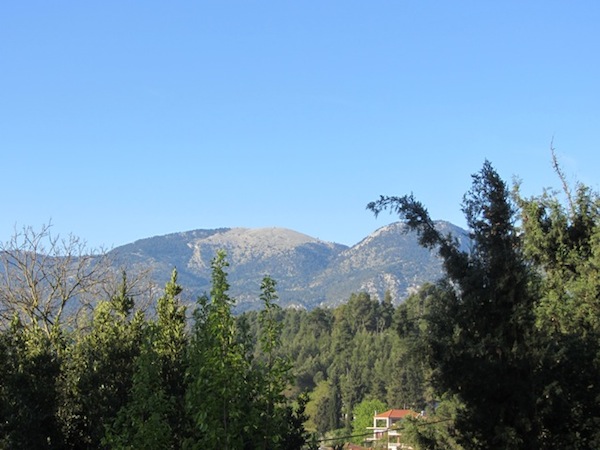
 ANDROS Greece—(Weekly Hubris)—10/7/2013—Where did we leave off? Last April, when I wrote the first part of this story about a glorious botanical/gastronomical four-day trip to Greece’s second largest island (https://weeklyhubris.com/traveling-with-angels-a-visit-to-northern-evia-part-i/), I fully intended to complete it by May. But Easter and summer intervened with their own diversions. Now that five months of blazing sun have leached all color but variations on dull beige out of our hills and valleys, I find myself looking forward to the autumn rains that will bring green back to our lives. And looking back to the spring when four sunny days in a row was a gift and not a given.
ANDROS Greece—(Weekly Hubris)—10/7/2013—Where did we leave off? Last April, when I wrote the first part of this story about a glorious botanical/gastronomical four-day trip to Greece’s second largest island (https://weeklyhubris.com/traveling-with-angels-a-visit-to-northern-evia-part-i/), I fully intended to complete it by May. But Easter and summer intervened with their own diversions. Now that five months of blazing sun have leached all color but variations on dull beige out of our hills and valleys, I find myself looking forward to the autumn rains that will bring green back to our lives. And looking back to the spring when four sunny days in a row was a gift and not a given.
On that weekend in mid-April when we set off, the weather was clear and balmy. This prompted a German friend to declare that we must be traveling with angels. I understood her to mean they were in the car with us. But, as another German friend explained after she’d read the story, “When lovely days occur—something that’s much less common in Deutschland—we say that ‘angels must be travelling.’”
But she liked my version better. And indeed, the winged messengers stayed with us—in the car and on our walks—until the very end of our trip, when thunderclouds loomed heavy on the horizon as we approached Athens. But they also brought a lightness of spirit, a reprieve from gloom, and kept our group, some 25 members of the Greek branch of the Mediterranean Garden Society (www.mediterraneangardensociety.org), happy and harmonious throughout, with not a Grinch among us.
So, a bit stiff from a hike up a mountain in search of the elusive wild peony, and more than replete from a feast of wild boar stew and other Lucullan mezedes and desserts, we said good-bye to our hosts from coastal Rovies (www.eleonashotel.com), and drove back into the heart of Northern Evia. We followed the familiar but never monotonous route under arcades of spreading plane trees along a river bed stippled with pink prunus blossoms, checking constantly with our next host for directions to his family estate.
Candili, named after the mountain above it, is one of the oldest foreign-owned properties in Greece. Formerly named Achmetaga, it was bought by Annabella Byron’s cousin Edward Noel from Hadji Ishmail Bey, an Ottoman pasha, in the 1830s. Lady Byron had dispatched her relative to investigate the circumstances of her mad bad husband’s death in Missolonghi. Given his reputation, she feared he might have been stabbed by a jealous husband but, as his descendant, current owner Philip Noel-Baker, told us over tea and wine in the garden later, “He was merely stabbed by a jealous mosquito.”
But Edward had been bitten by the love bug itself. He became passionate about the cause of Greek independence and began planning what he could do to help the country after liberation. He decided to study agriculture in Switzerland and He decided to study agriculture in Switzerland and then, with a Swiss friend, bought the 6,000-hectare (15,000-acre) estate, which was not only rich in timber and good soil but also possessed magnesite deposits, used as insulation in fire bricks.
Philip recounted the family history, as he must have done hundreds of times, with poise and humor, to a rapt audience. He told of the wild and dangerous early years when Athens was a long horseback ride over the mountains to Limni, followed by a long sail down the coast to the port of Rafina near Marathon, with the threat of brigands adding to the excitement. And of more domestic dangers, as when Edward’s son Frank lost his wife to the great-grandfather of our previous host at Rovies. (Frank’s children, motherless, were sent back to England, and his daughter Irene later married Philip Baker, a Quaker who worked to found the League of Nations, helped devise the provisions of Population Exchange between Greece and Turkey after the disastrous war of 1922, and eventually won a Nobel Peace Prize for his efforts at disarmament.)
After Irene donated a big piece of the estate towards settling refugees, a village grew up around the Noel-Baker estate consisting of Turkish-speakers from Ergup in Cappadocia. They arrived bearing a miracle-working saint, John the Russian, who turned his powers into making the subsequent Prokopi a pilgrimage site for devout Orthodox and, consequently, a steady source of income.
The family has always taken its responsibilities seriously, in the old-fashioned tradition of noblesse oblige. Philip and his son Francis both served as socialist MPs in England, but Francis and his Swedish wife, Barbro, also set up a foundation to improve the standard of living in the 25 villages in the area. Despite good intentions, tensions have always existed between the “foreigners,” the locals, and the Greek government—mostly involving land disputes. And the estate has shrunk considerably since 1835. Who knows how it will survive the current barrage of tax attacks on real estate?
Hoping to make Candili self-supporting, Philip Noel-Baker has converted the stables and granary into comfortable bedrooms that may be rented by groups for anything from a family reunion to a yoga retreat, mini-conference, or base for nature lovers like us. But although they look “old,” nothing is left of the original buildings. During World War II, drunken Italians stationed there unwittingly caused a fire in the living room that quickly burned through to the cellar, where they had stored explosives, and blew the whole place sky-high.
After the war, Philip’s grandmother lovingly had everything rebuilt as it was before, managing to re-infuse it with history, too, for many of its unique letters, paintings, and other valuables had been removed to safer places. The two-story, grey-walled house with its chintz slipcovers and English antiques didn’t look at all Greek, but Xenios Zeus, the god of hospitality, certainly reigned in the kitchen.
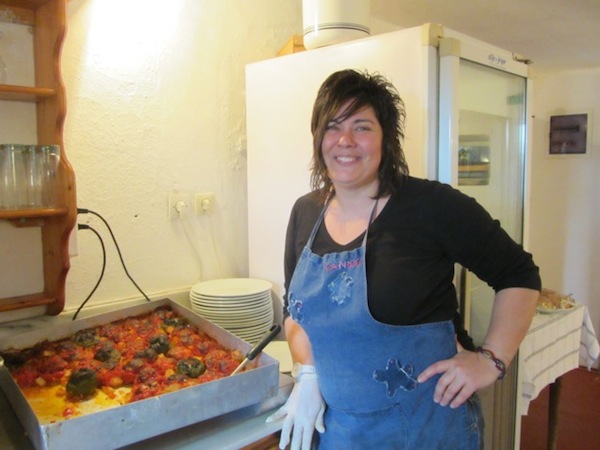
There, he had taken the form of Ioanna Gouvioti, a rosy-cheeked, pleasantly plump, 30-something culinary goddess. Incapable, according to Philip, of cooking for anything smaller than a crowd, she produced a banquet at every meal and left cookies, crumbles, an incredibly crisp, syrupless baklava, and those ineffable fried pastries called diples in the pantry for us to snitch at non-mealtimes. It was amazing how many of us seemed to drift in that direction. Her main dishes came from the standard Greek repertoire—pork exohiko (country stew), keftedes (meatballs), zucchini pie, stuffed tomatoes, and stuffed vine leaves—but they were anything but standard; each mouthful offered a complex blend of flavors that almost silenced conversation.
Accosting her in her domain, I asked her how she came to be such an astounding cook.
“Well, first of all, I love it,” she said. “I used to work in a taverna but, after I came to Candili, I had to become more versatile. So many different kinds of groups come here for workshops or retreats and I’ve had to learn how to cook for detoxers and vegans, but also for gourmets. One of the best things about my job is the annual meeting here of Australian chefs. They have taught me so many tricks, so I’ve learned techniques and seasonings you won’t find in too many Greek restaurants.”
Philip knows Ioanna is the ace up his sleeve. Which is why he suggested she give us cooking lessons between hikes in the countryside. On Saturday afternoon, after a stroll round the garden, a hunt for wild orchids, and an amble to an idyllic green picnic spot, we rolled up our sleeves around a large table in Candili’s courtyard and tried to master the art of turning vine leaves into envelopes for an herbed rice stuffing. Not all of us proved up to the task, but Ioanna said even the most clumsily folded dolmades would be hidden under an egg-lemon sauce and would taste just as good.
She was right.
For our final day, Philip led us on an invigorating walk along the east coast of Evia, where waves were breaking against dramatic cliffs and the flowers grew in such a thick and tangled carpet, you could not avoid crushing some. Then, appetites rekindled, we headed back to Candili for a last luscious lunch.
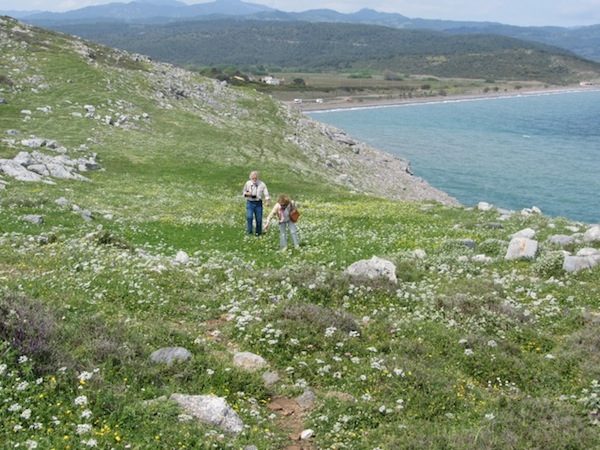
On the way home, storm clouds billowed, but I thanked the angels for staying with us and for helping out in the kitchen as well as blessing the botanists with enough spring blooms to satisfy the gardeners as well as the gourmands.

Recipes
Ioanna’s Stuffed Vine Leaves/Dolmadákia
These are also called Pséftikes or “Fake” dolmádes, because they contain no meat. In the same vein, Stuffed Tomatoes and Peppers without ground meat are called “Orphans” by fasting Greeks ruefully remembering the real thing.
You won’t find fresh vine leaves this time of year, but jars of brined leaves may be found in Greek and Middle Eastern shops everywhere, and are perfectly acceptable substitutes. You should count on at least six dolmádes per person, so 40-50 vine leaves is not an exorbitant amount.
40-50 vine leaves
250 grams/¼ lb long-grain rice
100 grams/big bunch fresh dill, finely chopped
3 spring onions (about 150 grams), finely chopped
1 medium dry onion (100 grams), finely chopped
salt and pepper
olive oil, at least ½ cup (120 ml)
First prepare the leaves by rinsing them under running water and then dip them into a pot of boiling water for 3 minutes, drain in a colander, and pat dry with paper towels. Spread them out on a table, rough side up, with the stems facing you. Cut off the stems and discard. Have ready a large baking pan or stewing pot and line the bottom with any torn vine leaves.
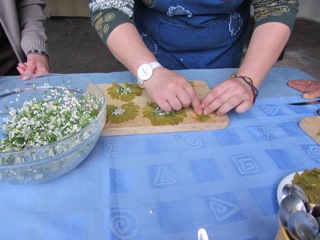
Mix all the dry ingredients together in a bowl and moisten with a few tablespoons of olive oil.
Place a teaspoon of the stuffing mixture at the stem end of the leaf, fold the right and left bits over the filling and then roll up to the tip. Place it, seam side down in the pan, and continue till you have run out of rice or leaves. They should be closely packed.
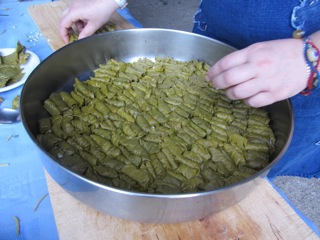
Pour in enough water to half cover along with some olive oil. If you were Greek, you might add ½ cup or more, but ¼ cup will do.
You can cook these on top of the stove very slowly or in an oven pre-heated to 180°C or 370°F. If you cook them on a low burner, cover the vine leaves with an old plate to keep them from shifting and falling apart. If in the oven, partially cover them with a sheet of foil.
Egg-lemon Sauce/Sálsa Avgolémono
2 eggs, separated
2 cups liquid from the dolmádes
1-2 tablespoons lemon juice
Beat the yolks and whites in separate bowls, the whites until they are quite stiff. Pour off the liquid from the dolmádes into a third bowl, and let cool for about 5 minutes. Add the lemon juice slowly to the yolks, stirring, then add the broth, a little at a time, and then fold in the egg whites. Pour the mixture over the hot dolmades and the dish is ready.
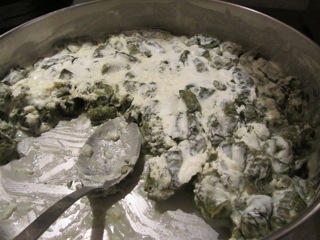

Note: For more information on Candili, visit the website www.candili.gr. You may also be able to order Barbro Noel-Baker’s wonderful book, An Isle of Greece, The Noels in Euboea, filled with stories about this remarkable place and its remarkable family (see http://deniseharveypublisher.gr/books/an-isle-of-greece).
